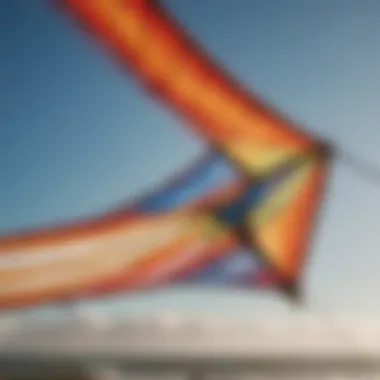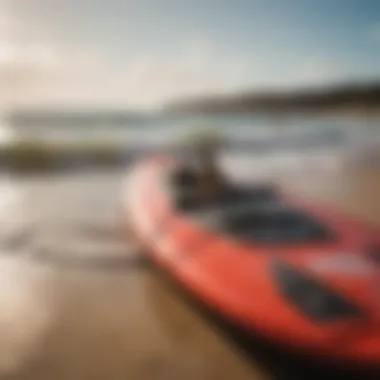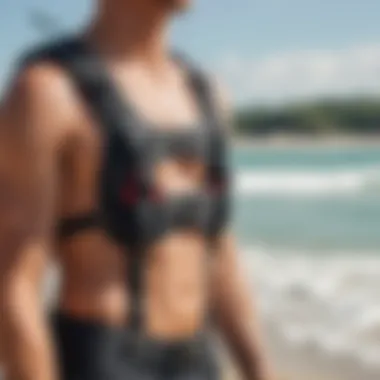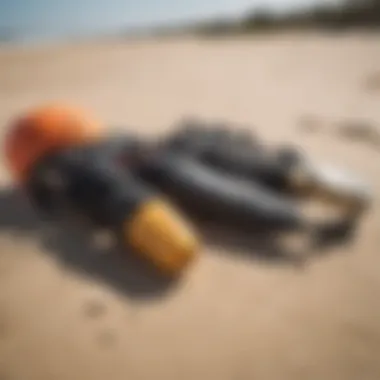Key Elements of a Kite Surfing Kit Explained


Intro
Kite surfing is a thrilling sport that blends the excitement of surfing with the dynamic forces of wind and water. For both newcomers and experienced riders, understanding the essentials of a kite surf kit is crucial. It’s not just about staying afloat; it's about harnessing the wind, making every session enjoyable, and enhancing performance.
When choosing a kite surf kit, it’s essential to grasp the core components involved. Kites, boards, harnesses, and safety gear all play significant roles, but they are not created equal. This guide will help you navigate the complex web of choices and nuances, considering factors like skill level and local conditions.
By taking a deep dive into gear selection, skill development, and maintenance, kite surfers will not only gain a better grasp of their equipment but also how to optimize their experience on the water.
Gear Selection
Types of Kites
Kites are the heart of your gear, and choosing the right one can transform your time on the water. Generally, there are three main types of kites used in kite surfing:
- Bow Kites: Known for their stability, these kites are favored by beginners and those who value safety. They provide a large wind range and are easy to relaunch if they fall.
- C Kites: These kites excel in performance and are typically preferred by advanced riders. They offer direct steering and a responsive feel but require a solid understanding of kite control.
- Delta Kites: Versatile and forgiving, delta kites combine some of the best characteristics of both bow and C kites. They can perform well in varied conditions, making them great for intermediate surfers.
Understanding the wind conditions at your location and your skill level will help narrow down which type suits you best.
Choosing the Right Board
Selecting a board for kite surfing is as essential as choosing the right kite. Boards vary in size, shape, and material. Each has its unique advantages:
- Directional Boards: Often used by surfers who want to ride waves. They look like a surfboard and are excellent for carving and riding in rough seas.
- Twin-Tip Boards: More popular among freestyle riders, these boards can be ridden in either direction. They’re often wider and designed for jumps and tricks.
- Foil Boards: Rising in popularity, these boards utilize a hydrofoil to lift above the water’s surface. They offer a unique riding experience and can slice through choppy water with ease.
When making a decision, think about your style. If you plan on catching waves, a directional board may suit you. For tricks on flat water, a twin-tip could be the way to go.
Skill Development
Essential Techniques
Kite surfing isn’t solely reliant on gear; understanding essential techniques is key. For beginners, mastering the basics such as kite control and body positioning is fundamental. Key skills include:
- Launching and Landing the Kite: A proper launch and landing can save you from potential hazards.
- Riding Upwind: This is crucial for getting where you want to go. Focus on edging and balancing your weight correctly.
- Water Starts: Getting up on the board quickly is vital for efficiency. Practicing this can lead to smoother rides.
Progression Tips
Once the basics are nailed, advancing your skills requires dedication. Consider these tips for progression:
- Practice Regularly: Consistent practice is essential. Even short sessions can build confidence.
- Join a Community: Engaging with fellow kiteboarders can provide insight and motivation. Online platforms like reddit.com have active groups where you can seek advice and share experiences.
- Take Lessons: Investing in professional instruction can dramatically shorten your learning curve and enhance safety.
Understanding Kite Surfing
When you peel back the layers of kite surfing, it’s not just about flying a kite or gliding across the water. It’s a dance with nature, synchronizing your movements with the wind and tide. This symbiotic relationship demands familiarity with various elements—like wind conditions, types of boards, and safety practices. The better you understand these components, the safer and more enjoyable your kite surfing experience will be.
Moreover, understanding kite surfing aids in recognizing the importance of selecting the right equipment tailored to individual skills and preferences. For instance, a starter might lean toward more forgiving kites, while experienced riders may chase the thrill of high-performance gear. All these factors converge to enhance not only your performance but also your enjoyment on the water.
Definition and Overview
Kite surfing combines elements of surfing, windsurfing, and paragliding. Riders use a large, controllable kite to harness wind power while standing on a board. The focus lies in propelling oneself across the water's surface, executing jumps, and performing tricks—all while being pulled by a kite.
In essence, kite surfing is deeply rooted in the rider’s ability to adeptly manage the forces at play. This sport is like juggling with the elements—keeping the kite aloft while maneuvering the board beneath your feet. Understanding how to manipulate the kite's power is critical; it can lead to exhilarating upward launches or face plant mishaps.
The Evolution of Kite Surfing Equipment
Kite surfing has come a long way since its inception in the late 20th century. The equipment has evolved remarkably, influenced by advancements in materials and design, which have aimed to enhance performance and safety.
- Kites: Initially, kites were quite cumbersome and less efficient. Today, modern kites are designed for various wind conditions, incorporating materials that are lighter yet durable. This evolution provides kite surfers with options to suit different riding styles and conditions.
- Boards: Early boards lacked versatility, whereas current models cater to directional and twintip preferences, allowing riders to choose what feels best for their approach. Some boards even have integrated technologies for improved stability and control.
- Safety Gear: Just as important as performance gear, safety equipment has seen improvements. Helmets, impact vests, and quick-release systems on harnesses have become standard practices to enhance safety on the water.
The evolution of kite surfing equipment reflects the industry’s commitment to progress.
"The past is the past, but today’s innovations fuel tomorrow's adventures."
As kite surfing evolves, riders benefit from continuous improvements that not only elevate the sport but also promote a safer riding environment.
Core Components of a Kite Surf Kit
Understanding the core components of a kite surf kit is crucial for anyone looking to navigate the waters with confidence and style. Each element plays a vital role in enhancing your overall kiteboarding experience. From selecting the right type of kite to ensuring that all equipment is compatible, each decision you make can significantly influence performance and safety.
The benefits of understanding these components are manifold. First, it allows you to tailor your gear to your unique style and skill level. Knowledge about different kites, boards, harnesses, and safety equipment not only helps you choose wisely, but it also contributes to a more enjoyable time on the water. A well-thought-out kit maximizes your ability to ride with ease while reducing the likelihood of mishaps.


Kites: Types and Functionality
Kites are arguably the centerpiece of any kite surfing kit. The choice of kite can determine how easily one can maneuver in various wind conditions. Here’s a closer look at three essential types:
Fixed Bridle Kites
Fixed bridle kites are known for their stability and ease of use. They feature a fixed point on the kite that keeps it battened firmly against the wind. This design lends itself to predictable performance, particularly suitable for beginners who are still mastering their control on the water.
One of the standout characteristics of fixed bridle kites is that they tend to perform well in a wide range of wind conditions. This versatility makes them a popular choice for many kite surfers. However, it's worth noting that while stability is a plus, they may not offer the same level of performance as some other kite types in extreme conditions.
Soft Kites
Soft kites, often referred to as inflatable kites, boast a lightweight structure that's packed down easily for transport. Their design allows for flexible flight characteristics and the ability to absorb impact from wind gusts, making them a favorite among freestyle riders.
A key characteristic of soft kites is that they provide excellent lift and glide. This means many riders find they can maintain speed even in lighter wind conditions, enhancing their riding style.
However, the lightweight nature can also make them more susceptible to being pulled or overpowered in strong wind. Riders need to be cautious and aware of wind shifts.
Depowerable Kites
Depowerable kites are equipped with mechanisms that allow riders to adjust the power of the kite during use. This feature is particularly beneficial for intermediate to advanced surfers, as it empowers them to handle various wind conditions while maintaining control.
The main advantage of depowerable kites lies in their ability to adapt quickly to changes in wind pressure, giving riders more freedom to execute maneuvers and jumps without losing control. On the downside, mastering this equipment might take some time, requiring a level of skill that not all beginners possess.
Boards: Choosing the Right Style
After kites, boards are the next major component of your kite surfing experience. The right board can make a world of difference; different styles cater to distinct riding preferences and environments.
Directional Boards
Directional boards are designed for surfing the waves. They have a single fin and are built for performance in ocean conditions. The main advantage is their superior control when riding downwind, making them a favorable choice for more experienced surfers.
However, directional boards can limit maneuverability because they’re not made to ride switch or backward, which some riders may find restricting.
Twintip Boards
Unlike directional boards, twintip boards can be ridden in either direction, making them incredibly versatile. They’re designed ergonomically for easier jumps and tricks, catering well to freestyle and beginner riders.
Their great edge control and stability make them a popular choice. But some may find them less effective on choppy waters compared to directional options.
Foil Boards
Foil boards are a relatively new addition to the kite surfing world. The foil underneath lifts the board above the water, reducing drag and providing a smooth ride even in low wind conditions. They are great for riders looking to push their limits.
On the downside, they require a learning curve, as the sensation of riding a foil is notably different, and can sometimes be tricky for new surfers.
Harnesses: Types and Importance
Selecting the right harness is just as important in kite surfing. Harnesses transfer the pull of the kite to the body, freeing up the arms for steering and control. There are several styles available:
Waist Harnesses
Waist harnesses are the most commonly used style among kite surfers. This harness sits comfortably on the rider's waist and provides excellent freedom of movement.
One of their key advantages is the added comfort for long sessions. However, some riders may find that they ride up during tricks, which can be distracting.
Chest Harnesses
Less common but very useful, chest harnesses offer an alternative for those who prefer pulling from their chest instead of the waist. They can provide additional support for some riders. Depending on the wind strength and conditions, this harness style can reduce discomfort.
Yet, they may limit the natural movement of the torso, which can be a drawback for more dynamic riding styles.
Seat Harnesses
Seat harnesses are especially well-suited for heavier loads. They distribute pressure across the thighs and hips, which can be more comfortable for long-duration riding.
The unique design provides additional support for the lower back, making them great for beginners still getting used to the sport. However, their bulkiness can inhibit freedom of movement, which may frustrate advanced riders.
Lines and Bar: Function and Material


The lines and control bar connect the rider to the kite and directly influence handling and control.
Control Bars
The control bar is critical for steering. A quality control bar gives you better feel and response from your kite. Bars come in different widths and designs, which can influence how the kite performs.
Some bars are equipped with quick release mechanisms for easier detachment in emergencies. While they generally enhance safety, cheaper options might compromise on features or comfort.
Lines Materials
Lines are usually made from materials like Dyneema or Spectra, known for their strength and minimal stretch. The right material can ensure your kit holds up against demanding conditions.
However, some materials can degrade faster in harsh sunlight, so it's necessary to check maintenance practices as well.
Line Length Considerations
Line lengths can affect the power and responsiveness of your kite. Longer lines can offer more height and efficiency, but they also require more skill to manage. Shorter lines give quicker response times but may reduce lift. Balancing this consideration is key when setting up your kit.
Safety Equipment: Essential Gear
Safety equipment cannot be overlooked. It's non-negotiable that every kite surfer invests in the right safety gear, which can prevent serious injuries.
Impact Vests
Impact vests are designed to absorb shock during falls, reducing the risk of injury. They provide buoyancy, which can help a rider stay afloat in distress.
One must provide good fit and comfort. A poorly fitted vest might not offer expected protection. This gear remains crucial, especially for beginners.
Helmets
Helmets are another item that offers vital head protection. Given the risk of falls and collisions with equipment, wearing a helmet is a sound decision. Additionally, modern helmets are often lightweight, making them easier to wear without sacrificing safety.
The downside? Some riders find them bulky, which in some cases may interfere with your riding. Still, their protective value far outweighs the cons.
Safety Leashes
Finally, safety leashes connect the kite to the rider, acting as a failsafe during unexpected moments. They allow the rider to keep connected to the kite without holding on. If a sudden wipeout occurs, it ensures the kite doesn’t drift away, which is critical for both personal safety and environmental concern.
While often overlooked, this simple piece of gear is one of the most essential for avoiding hazardous situations out on the water.
Selecting Your Kite Surf Kit
Selecting the right kite surf kit is a crucial step that can make or break your experience on the water. Your gear not only impacts your performance, but also can affect your enjoyment and safety while kite surfing. Therefore, understanding what to look for when choosing your kit is essential.
Factors to Consider
Skill Level
Your skill level plays a pivotal role in determining the type of equipment you should invest in. Beginners often require gear that offers stability and ease of use. For example, a kite with a larger surface area will provide more lift, helping new kiteboarders stay afloat longer.
On the other hand, experienced riders might prefer more responsive kites that allow for greater maneuverability and tricks. Choosing equipment that matches your skill level makes learning smoother and allows you to progress more quickly. However, if a beginner attempts to use advanced gear, it may lead to frustration or accidents.
Local Conditions
Understanding local conditions—including wind patterns, water type, and wave size—can significantly influence your equipment choice. If you typically ride in lighter winds, for instance, you'll want a kite designed for performance in such settings. This choice can enhance your experience and ensure you aren't underpowered. Conversely, in strong winds, a smaller kite may suit you better to manage control without feeling overpowered.
Each beach has its quirks, so knowing what to expect can help you avoid bad surprises. Think of local conditions as the stage upon which you perform; if it’s not set right, the show may not go well.
Budget Constraints
Every kite surfer needs to reckon with their budget. While it’s tempting to want the latest and greatest gear, having a budget that aligns with your goals can lead to better choices.
For instance, some newcomers might suffice with a mid-range setup, allowing them to gain experience without breaking the bank. Great equipment doesn't always come with a hefty price tag, and many reliable brands offer affordable options.
However, scrimping on safety gear is an absolute no-go. Investing in quality safety gear is wise, as it helps protect you while you learn. Always balance your choices with what fits your pocket while ensuring safety and performance.
Compatibility of Equipment
When you're piecing together your kite surf kit, compatibility among equipment mustn't be overlooked. Mismatched gear can create chaos on the water, hindering your performance.


Kite and Board Pairing
Kite and board pairing is perhaps one of the most important aspects of selecting your kit. Every kite has a recommended compatibility with certain board types, and failing to follow this can lead to a frustrating ride. For example, a directional board typically pairs well with kites designed to go upwind effectively.
Finding a harmonious match means your kite can apply the right amount of pull to your board size and shape, resulting in a more enjoyable ride. This synergy enhances not only comfort on the water but also control, allowing you to explore the full potential of the equipment.
Harness and Bar Synergy
The connection between your harness and control bar also deserves attention. The right harness should fit snugly and allow for comfort and movement while you’re riding. If your harness doesn't sync up well with your bar, transitioning and executing maneuvers can be a cumbersome task.
Plus, a well-chosen bar can afford better response times and feel in the air. Think of this relationship as a well-rehearsed dance; if one partner isn’t in sync, the performance falters.
Choosing wisely based on these factors ensures you have a well-balanced and enjoyable experience when kite surfing.
Maintenance and Care for Your Kit
Taking proper care of your kite surf kit is crucial. Regular maintenance not only prolongs the life of your equipment but also ensures your safety when you’re out on the water. Imagine this: you're gliding over waves, enjoying the rush of the wind, but a sudden equipment failure could turn this blissful experience into a serious hazard. By being proactive, you can prevent mishaps and keep your kit functioning at its best.
Caring for your kit involves several important aspects. Disregarding these can lead to costly repairs or, worse yet, accidents. Let’s break down the key facets into manageable components to understand better what is involved in maintenance and care for your kite surf kit.
Regular Inspection Procedures
Every time you hit the beach, consider implementing a checklist for inspecting your equipment. You don’t want to find out something is off while you’re already out there. Regular inspections help spot potential problems before they escalate. Here’s a simple breakdown:
- Kite Condition: Look for any rips, tears, or punctures. Pay attention to the seams and leading edges, as these areas are often under significant stress.
- Lines Check: Examine your lines carefully. Look out for fraying or any signs of unusual wear. It’s good practice to replace lines if they show any significant damage.
- Control Bar Review: Inspect the control bar for any dents or corrosion. Make sure the safety system functions correctly and that the depower straps aren’t jammed.
- Board Assessment: Check your board for dings or cracks. A small problem can often lead to a bigger issue if left unchecked.
"A stitch in time saves nine." Regular inspections can prevent costly repairs and ensure a safe ride.
Storage Solutions
Where you store your kit when not in use can make a sizable difference in its longevity. It's tempting to just toss everything into a corner of your garage or shed, but that can lead to unwanted deterioration. Here are some storage suggestions to keep your equipment in top shape:
- Dry Environment: Always store your gear in a cool, dry place to minimize moisture buildup that might lead to mold or mildew.
- Keep it Clean: Rinse your kit with fresh water after every use to remove salt and sand. They can wear out materials over time.
- Organized Space: Use bags or bins specifically designed for kite surfing equipment. This avoids clutter and protects your gear from potential impacts or damage.
- Avoid Direct Sunlight: UV rays can degrade your kite’s materials. Store your kites in a shaded area or cover them when not in use.
Repair Techniques
Repairs are sometimes unavoidable, especially with heavy usage. Being familiar with basic repair methods can come in handy, so you’re not left stranded. Here are common repair techniques:
- Patching Tears: Use kite repair tape for quick fixes. It’s designed to hold strong against the wind and water. A well-patched kite can still perform effectively.
- Replacing Lines: If you find fraying or worn-out lines, replace them rather than attempting to repair. Your safety should always be the top priority.
- Fixing Dings on Boards: For minor dings, DIY repairs with epoxy resin work well. Be sure to sand down the area first for a smoother finish.
- Harness Repairs: If a buckle or strap on your harness breaks, look for user-friendly replacement kits or consult a professional.
With these strategies, you can ensure your gear remains in peak condition and ready to tackle whatever the ocean throws your way. By integrating regular inspections, proper storage methods, and basic repair techniques into your routine, you’ll find that maintaining your kit is not only easy but essential to a safe and enjoyable kite surfing experience.
Advancements in Kite Surf Technology
Kite surfing has come a long way since its inception. As technology evolves, so too do the very elements that make this sport exhilarating. Understanding advancements in kite surf technology is vital not only for enhancing performance but also for ensuring safety and sustainability. This section explores emerging trends and environmental considerations that are shaping kiteboarding equipment for enthusiasts, instructors, and even event organizers.
Emerging Trends in Equipment Design
The kite surfing community is watching closely as manufacturers roll out innovative designs aimed at improving both functionality and user experience. These trends have shifted dramatically over time, driven by feedback from kiteboarders who are always in search of a competitive edge.
- Material Innovation: New materials like ripstop nylon and reinforced polyester have become commonplace in kite design. They provide better durability while remaining lightweight, which is essential for aerial maneuvers and overall agility on the water.
- Shape and Construction: Kites are now designed with a focus on specific wind conditions. For example, hybrid shapes, combining attributes from different types, give riders versatility and adaptability across various environments.
- Smart Technology: Incorporating sensors into equipment is another thrilling frontier. Imagine kites that can give real-time feedback on wind patterns or performance metrics. This tech-savvy approach could help improve training and skill development for both novices and seasoned kite surfers.
- Customization Options: The advent of modular systems allows kiteboarders to customize components easily. This means riders can swap out parts based on their riding style or changing conditions, ensuring an optimized experience no matter where they are.
Overall, the drive towards innovation helps kite surfers connect more deeply with their sport while enhancing the accessibility of kiteboarding for newcomers.
Environmental Considerations in Manufacturing
As kite surfing grows in popularity, so does its impact on nature. The industry is increasingly recognizing the need for sustainable practices in equipment manufacturing. This focus not only addresses environmental concerns but also attracts eco-conscious consumers.
- Sustainable Materials: There’s a shift towards using recyclable and biodegradable materials in the production of kites and boards. Manufacturers are exploring alternatives to traditional plastics, such as ecological composites, which lessen the ecological footprint of equipment.
- Production Practices: Companies are re-evaluating their supply chains. This means reducing waste during production and promoting ethical labor practices. These movements not only support the environment but also resonate with consumers who prioritize responsible businesses.
- End-of-Life Solutions: As kiteboarding equipment has a life cycle, manufacturers are investigating programs for recycling or repurposing old gear. This effort minimizes landfill waste and promotes a circular economy in the sport.
- Community Initiatives: Many brands are now part of environmental movements, participating in beach clean-ups and wildlife conservation efforts. This contributes to a positive brand image while fostering community engagement.
The advancements in kite surf technology indicate a bright future not only for the sport but also for the planet. Enthusiasts can look forward to riding the waves while making informed choices that align with their values.
End: Curating Your Perfect Kit
When it comes to kite surfing, piecing together your ideal kit is not just a matter of grabbing a few pieces of gear and hitting the water. The art of curation involves a thoughtful approach that looks at your individual style, experience level, and the specific conditions you'll be facing. The right kit can make all the difference, transforming the challenge of balancing on a board while tugged by the wind into an exhilarating experience.
One of the first steps in this curation process is understanding how each component interacts with one another. Compatibility is key. It’s not enough to choose the latest and greatest kite if it doesn’t work well with your board or harness. For instance, mismatched size and type can lead to poor performance, making your time on the water frustrating, instead of the thrilling adventure it should be.
"Choosing the right gear is like selecting the right tools for a job. Get the wrong one, and things can go south in a hurry."
Additionally, consider the local conditions where you plan to ride. Different environments call for different types of kites and boards. Are you going to be battling strong winds or gentle breezes? Will you be riding in choppy waters or smooth bays? Tailoring your kit to these factors not only improves your safety but enhances your overall experience.
Another factor that often gets overlooked is budget constraints. High-end gear can be tempting, but it’s essential to stay realistic about what you can afford. Often, the latest trendy gear doesn’t add much value to your sessions, especially if you’re still honing your skills. Instead, think about investing in quality components that fit your level while leaving room for upgrades as you progress.
Assembling your ideal kite surf kit doesn’t have to feel daunting. Take the time you need to research brands and read reviews. Talk to fellow kiteboarders, both seasoned veterans and fresh faces alike. Forums on sites like Reddit can be a goldmine of information, often brimming with personal experiences that can provide valuable insights.
In summary, curating your kite surf kit is a balancing act of performance, compatibility, local conditions, and budget. Strive to find harmony among these elements, and you won't just hit the water; you’ll ride waves with confidence and ease. The next time you’re out looking at gear, remember: what you bring along can always add to your adventure, or sometimes, it may just hold you back. Choose wisely.















